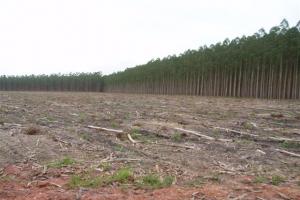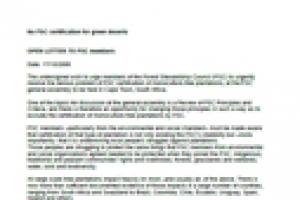With the ideological discourse of big capital masquerading as sustainable development and as saviours of the poor, the pulp giants advance on the State of Rio Grande do Sul. With their capital they finance electoral campaigns, pay for misleading advertising and twist public power around their little fingers.
Brazil
Other information
8 November 2007
Other information
8 November 2007
The Government of the State of Bahia, through the Centre for Environmental Resources, (CRA) held a seminar on 7 and 8 November with the purpose of “initiating a process of discussion and reflection on the environmental, social and economic prospects of eucalyptus plantations in the South and Extreme South of the State, taking a territorial approach as a basis, centring on the construction and consolidation of public policies for the region.” This event represented the continuity of a process of discussion launched in June this year by the CRA, seeking participative and negotiated solutions
Other information
8 November 2007
In order for vast extensions of industrial plantations to be viable in Brasil direct interactions where established between the government, companies, banks, universities, media, as well as with international and financial institutions, producers and buyers. A broad political orchestration resulted in the creation of a number of mechanisms related to legal, taxation, financial, technical, scientific, agrarian and logistic support. In the same manner articulations opposing those policies increased as monocultures expanded.
Other information
17 October 2007
The invasion of local peoples’ territories by Aracruz Celulose S.A.’s agro-industrial project, established in the sixties and seventies in Espirito Santo, caused enormous material and symbolic losses to the indigenous and quilombola peoples. Some are irrecoverable.
Bulletin articles
17 September 2007
Introduction
On 27 August 2007, Tarso Genro, the Brazilian Minister of Justice, signed the ministerial resolutions delimiting the Tupinikim (14,227 hectares) and Comboios (3,800 hectares) Indigenous Lands, totalizing 18,027 hectares.
According to the resolutions, the Brazilian Government recognizes that the lands have traditionally been occupied by the Tupinikim and Guarani peoples and that, over the past 40 years, they had been illegally occupied by Aracruz Cellulose.
Bulletin articles
17 September 2007
-Werá Kwarai
Bulletin articles
17 September 2007
Although the struggle for 11,009 hectares of Tupinikim and Guarani land in the hands of the greatest eucalyptus pulp exporter in the world, Aracruz Cellulose, was a major challenge, the reoccupation of this territory and reconversion of eucalyptus in the zone to other land uses is perhaps an even greater one. Over the past 40 years, more than 90% of the area has been occupied and exploited by monoculture eucalyptus plantations, causing degradation of countless streams and rivers, killing the fish and contaminating the scant water left for the indigenous people to drink, bathe and wash thei
Bulletin articles
18 August 2007
For over a decade WRM has been gathering, producing and disseminating information and analysis on the social and environmental impacts of fast wood plantations, characterized as large-scale, fast-growth tree monocultures. At the same time, we have been stressing that such plantations should not be certified, focusing on the Forest Stewardship Council (FSC), this being the scheme certifying most of such plantations.
Bulletin articles
18 August 2007
Veracel Celulose – a joint venture between the Swedish-Finnish company Stora Enso and the Norwegian-Brazilian company Aracruz Celulose - has launched a process to obtain FSC certification for its eucalyptus plantations in the extreme south of the State of Bahia. For this purpose, it has hired the consulting firm SGS.
Bulletin articles
18 August 2007
Once again, Stora Enso and Aracruz are using their economic power to mislead and wheedle. In addition to misleading and wheedling the Brazilian people, they are now misleading and wheedling Northern society with the aim of increasing the price of their products, increasing their sales and therefore, their profits! With this purpose, the Veracel pulp company presented itself voluntarily to FSC certification and resorted to SGS ICS, with headquarters in Sao Paulo, as certifying body.
7 August 2007
Veracel - which belongs to the Swedish-Finnish company Stora Enso and the Norwegian-Brazilian company Aracruz Celulose - is attempting to obtain certification for its plantations established over 78,000 hectares in the extreme south of the State of Bahia and its impacts are causing major local resistance.
Other information
23 July 2007
By Raúl Zibechi.
Source: Programa de las Américas - www.ircamericas.org


